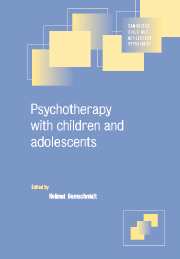Book contents
- Frontmatter
- Contents
- List of contributors
- Preface
- Part I Principles of psychotherapy with children, adolescents and families
- Part II Psychotherapeutic methods and settings
- 5 Psychodynamic therapy
- 6 Behaviour therapy
- 7 Cognitive behaviour therapy
- 8 Interpersonal psychotherapy for adolescents
- 9 Play therapy with children
- 10 Individual psychotherapy with adolescents
- 11 Group psychotherapy and psychodrama
- 12 Family therapy
- 13 Parent training
- 14 Combination of treatment methods
- Part III The practice of psychotherapy for specific disorders in childhood and adolescence
- Part IV The practice of psychotherapy in various settings
- Index
12 - Family therapy
- Frontmatter
- Contents
- List of contributors
- Preface
- Part I Principles of psychotherapy with children, adolescents and families
- Part II Psychotherapeutic methods and settings
- 5 Psychodynamic therapy
- 6 Behaviour therapy
- 7 Cognitive behaviour therapy
- 8 Interpersonal psychotherapy for adolescents
- 9 Play therapy with children
- 10 Individual psychotherapy with adolescents
- 11 Group psychotherapy and psychodrama
- 12 Family therapy
- 13 Parent training
- 14 Combination of treatment methods
- Part III The practice of psychotherapy for specific disorders in childhood and adolescence
- Part IV The practice of psychotherapy in various settings
- Index
Summary
Introduction
Family therapy is a commonly used approach to treat disorders in childhood and adolescence. An important impetus for the development of family therapy was the ‘double-bind’ theory of schizophrenia (Bateson et al., 1956) and other family theories of schizophrenia (Lidz, 1958; Wynne and Singer, 1963). Simultaneously, but independently family-orientated techniques were developed on the basis of clinical experience with families. Early pioneers of this development include Ackerman (1958), Bowen (1960), Haley (1963), and Satir (1964). Minuchin (1974) introduced family therapy techniques in the field of child and adolescent psychiatry. The ‘Milan group’ (Selvini-Palazzoli et al., 1978) had a great influence on family therapy, especially during the phase in which the technique became popular. This is reflected by the fact that the term ‘systemic family therapy’ is often used to refer to the approach developed by the Milan group, whose therapeutic techniques were based explicitly on the systems theory developed by Bateson (1972). However, systemic ideas have influenced all schools of family therapy, even where this is not so obvious. Madanes and Haley (1977) have proposed a way of distinguishing different family therapies.
(i) Strategic family therapy includes approaches developed by Watzlawick et al. (1974) and the ‘Milan approach’ developed by Selvini-Palazzoli et al. (1978). Both approaches are based on the prinicples of systems theory initially introduced by Bateson (1972).
[…]
- Type
- Chapter
- Information
- Psychotherapy with Children and Adolescents , pp. 179 - 211Publisher: Cambridge University PressPrint publication year: 2001



